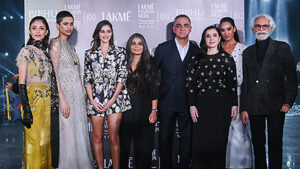Life came full circle when Orissa-born and now New York-based Indian fashion designer Bibhu Mohapatra met former US first lady Michelle Obama, a thinking mind, who understands politics, as well as she does style. “I was at the White House before she came to India on an official trip wearing my ensembles. I held her hand and told her how it feels for an immigrant designer to dress her. In FIT, NY, where I was studying, we had a project to create a dress for the First Lady, I never knew that one day I would be dressing her,” says Bibhu.
Michelle knows what to wear, is super inspiring and the only addition by Bibhu was to help her find a balance in looks. “She is aware of her roots, is grounded, humble; she has always worked towards lifting communities and encouraging young fashion designers,” he says.

Bibhu left Orissa to study economics in Utah in the US, but his soul was in design, which took him to FIT, and 20 years later he is the most respected talent from India in the US. But that’s not all. Dressing the current First Lady Jill Biden is also in the offing.
Interestingly, the style guru is working on and has always loved Ikkat (weaving style) from Orissa, and feels sometimes Indians take their own crafts for granted, without realising their innate beauty. “I did a small project in Orissa with Rita Kapur Chisti. The state government-sponsored my 18-month assignment where I worked with Orissa State Handloom Weavers’ Cooperative Society and Sambalpuri Bastralaya to improve designs of saris, producing 30 interesting concoctions,” he explains. What he really wants to do will benefit the weavers directly, as most of them are now leaving this profession to work in call centres in Metropolitan cities. “I lost both my parents some years ago, but I do remember my mom wearing beautiful ikkat saris, and I had an extremely happy childhood,” he says, adding that his home state Orissa was once a land of traders who took ikkat to Bali and other nations.
Bollywood is now etched in fashion, and is an undeniable and integral part of it. Bibhu understands its reach. Priyanka Chopra and Deepika Padukone have chosen him as their designer, but his style icon is Rekha. “Manish Malhotra introduced me to her and I have never felt more speechless. But Rekha has that power over me,” he laughs.

Today his label boasts of a store in Manhattan, a dream he never thought he could achieve, growing up in a middle-class family. Showcasing in India for the first time a line titled ‘Come Home’, he believes “India is in me, it’s my heritage. The very foundations of my aesthetic sensibility are formed by India, its arts, and artisans. Any piece in my collection has Indian textile surface treatment and embroidery. It is done by the artisans of India. Quite literally, there is a piece of India in most of my lines. He adds that it was a “pinch”- me” moment showcasing in India, as his heart was exploding with joy.
The most wonderful part was to get plaudits from celebrities like Bipasha Basu, Simone Singh, Ananya Pandey, Lisa Hayden, as well as artisans, who made the ensembles and worked on the intricate embroideries together on the same platform. “I believe I didn’t make the choice to pursue a career in design, it chose me. I just went along and did the work I needed to do. However, the limited global exposure of my childhood was compensated by the rich and incredible creative craft of Odisha,” says Bibhu.
What also brought him to India after Covid is his niece’s wedding in Hyderabad, which he is organising after his brother died from the disease. India, he believes, has been a leader in design and the world has been borrowing from ‘us’ without giving due credit.
Fashion is about exclusivity, and even the US had to struggle initially, as Paris was the fashion capital. “India is the hub of original ideas and it is poised to take a leap. Look at Rahul Mishra and what he has achieved in a short span of time. Or Gaurav Gupta and Sabyasachi Mukherjee. They are all my friends and I am so proud of them,” he says.

For Lakme Fashion Week, he brought his most iconic looks that he showcased at the New York Fashion Week 2023, which have contributed to the DNA of the brand. We hang it at our showroom and it sells,” he said. He adds his clothes do not convert someone into someone else, but makes them more of themselves.
His aim for the buyer is empowerment, by allowing them to present their best versions. From Dior to Elie Saab every international luxury guru sources from India, but Made in India needs more recognition. “The world, for decades, borrowed the Indian craft and its artistic currency but never saw it or considered it to be a major source of relevant fashion that resonates with a global audience. Now the tables have turned and finally the incredible talents of India are getting their due credit and well-deserved attention from the world. This is just the beginning,” he adds.
The USP of his brand is that it is democratic in nature and his clothes have a life beyond one season. “Like in any business it must maintain a balance to sustain and grow. In my area of expertise, it is about maintaining the balance of creativity and commerce for it to stay relevant, sustain and evolve,” he says.


Leave a Reply